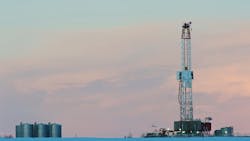Almost half of the more than 25,000 shale gas and oil wells in the United States are located in areas where water supply is already stressed, a new report from sustainability organization Ceres has revealed. Researchers warn that fracking to extract shale gas poses risks to water supplies in regions like Texas and Colorado, which are already seriously threatened by drought.
The report, Hydraulic Fracturing & Water Stress: Growing Competitive Pressures for Water, says that fracking operators should increase water reuse and the amount of non-fresh water used in order to limit their reliance on fresh water that could be used for other purposes. Hydraulic fracturing, or fracking, is a process in which shale gas is extracted from underground rock formations but it requires extremely large amounts of water in the process.
Researchers used drilling and water use data for 25,450 wells that were in operation between January 2011 and September 2012 and compared this with water stress indicator maps created by the World Resources Institute. Results showed that 47 percent of the wells were developed in water basins with high or extremely high water stress, which is defined as cases where more than 80 percent of the water available in the area is already allocated for municipal, industrial and agricultural uses.
Two states were found to be most vulnerable in terms of water stress: Colorado and Texas. In the former, 92 percent of all wells are situated in areas with extremely high water stress, whereas in the latter more than half of wells were located in such areas. Texas, however, accounted for nearly half of all surveyed wells. Fracking used more than 20 percent of the local water in certain parts of the state, the report showed. In Pennsylvania more than two-thirds of the wells were in medium to high water stress areas, but just two percent were in high water stress basins.
RELATED: Shell to start fracking in Colorado
Ceres noted that the industry has made progress in terms of water reuse, recycling and use of alternative water sources such as wastewater, saline water, seawater and acid-mine drainage that they utilize in fracking operations, but the organization highlighted the importance of boosting these processes and further reducing the use of fresh water.
In order to facilitate this, the report recommended several steps for fracking operators and regulators to take. It proposed that companies should be required by law to provide comprehensive information regarding the amount of freshwater, non-freshwater and recycled water used in operations by region, as well as details about how much of this water is returned to the surface and where. Another recommendation stated that companies should have targets on the quantity of the different types of water they have to use. The report also called for a more effective water management planning from both businesses and regulators and proposed that companies have a local stakeholder engagement process in place on water issues.

